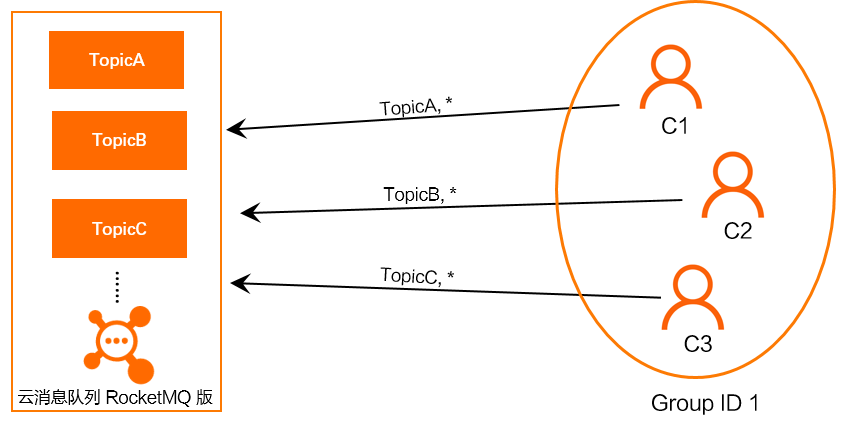订阅关系一致指的是同一个消费者分组Group ID下,所有Consumer实例所订阅的Topic和Tag必须完全一致。如果订阅关系不一致,可能导致消息消费逻辑混乱,消息被重复消费或遗漏。
什么是订阅关系一致?
云消息队列 RocketMQ 版里的一个消费者分组Group ID代表一个Consumer实例群组。对于大多数分布式应用来说,一个Group ID下通常会挂载多个Consumer实例。
云消息队列 RocketMQ 版的订阅关系指的是指定某个消费者分组Group ID对于某个主题Topic的订阅,包括订阅Topic时的过滤条件。
因此,订阅关系一致性的范围是同一Group ID下所有消费者对于指定Topic的订阅都相同。其中包括:
订阅的Topic必须一致。
例如:Consumer1订阅TopicA和TopicB,Consumer2也必须订阅TopicA和TopicB,不能只订阅TopicA、只订阅TopicB或订阅TopicA和TopicC。
订阅的同一个Topic中的Tag必须一致,包括Tag的数量和Tag的顺序。
例如:Consumer1订阅TopicB且Tag为Tag1||Tag2,Consumer2订阅TopicB的Tag也必须是Tag1||Tag2,不能只订阅Tag1、只订阅Tag2或者订阅Tag2||Tag1。
订阅多个Topic时Topic的类型一致。
例如,Consumer1和Consumer2都同时订阅TopicA和TopicB,则这两个Topic的类型必须一致,必须都是普通消息或者都是顺序消息。云消息队列 RocketMQ 版支持的消息类型,请参见消息类型列表。
正确的订阅关系如下,多个Group ID分别订阅了不同的Topic,但是同一个Group ID下的多个Consumer实例C1、C2、C3订阅的Topic和Tag都一致。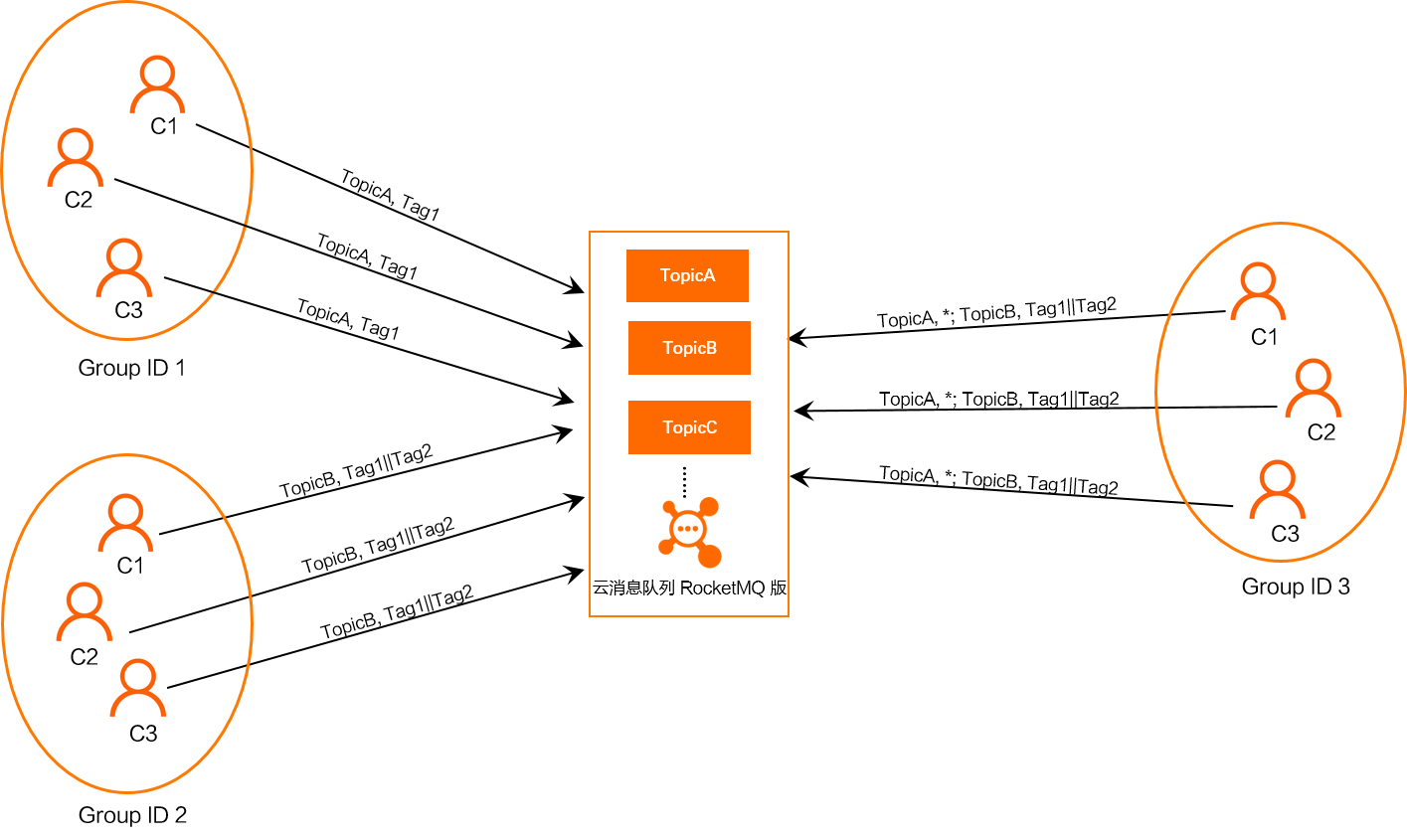
云消息队列 RocketMQ 版支持使用TCP协议和HTTP协议的SDK客户端收发消息,除了保证同一Group ID下的Consumer实例订阅关系一致,还必须保证订阅消息的Group ID的协议版本和SDK的协议版本一致,例如,使用TCP协议的SDK收发消息,订阅消息时也必须使用创建的TCP协议的Group ID,否则会导致消息消费失败。
如何查看订阅关系是否一致?
操作入口如下:
登录云消息队列 RocketMQ 版控制台,在实例列表中单击目标实例名称,进入实例详情页面。
在左侧导航栏单击Group 管理,然后在Group列表单击目标Group名称。
在Group 详情页面的订阅关系区域查看指定Group的订阅关系是否一致。
正确订阅关系一:订阅一个Topic且订阅一个Tag
如下图所示,同一Group ID下的三个Consumer实例C1、C2和C3分别都订阅了TopicA,且订阅TopicA的Tag也都是Tag1,符合订阅关系一致原则。
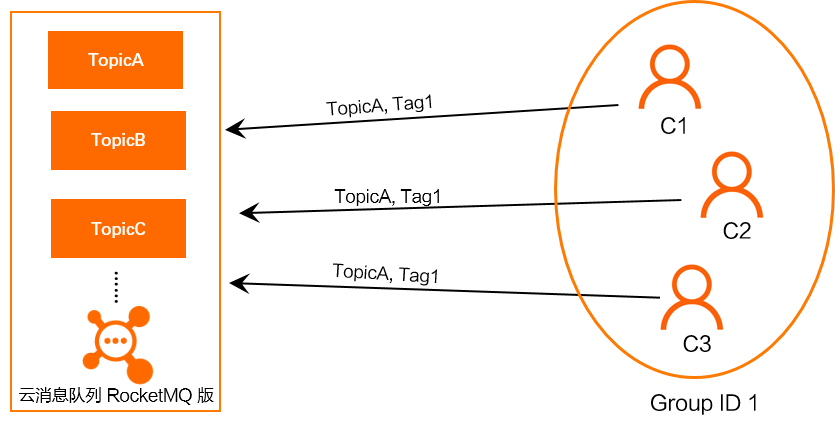 正确示例代码一
正确示例代码一
C1、C2、C3的订阅关系一致,即C1、C2、C3订阅消息的代码必须完全一致,代码示例如下:
Properties properties = new Properties();
properties.put(PropertyKeyConst.GROUP_ID, "GID_test_1");
Consumer consumer = ONSFactory.createConsumer(properties);
consumer.subscribe("TopicA", "Tag1", new MessageListener() {
public Action consume(Message message, ConsumeContext context) {
System.out.println(message.getMsgID());
return Action.CommitMessage;
}
}); 正确订阅关系二:订阅一个Topic且订阅多个Tag
如下图所示,同一Group ID下的三个Consumer实例C1、C2和C3分别都订阅了TopicB,订阅TopicB的Tag也都是Tag1和Tag2,表示订阅TopicB中所有Tag为Tag1或Tag2的消息,且顺序一致都是Tag1||Tag2,符合订阅关系一致性原则。
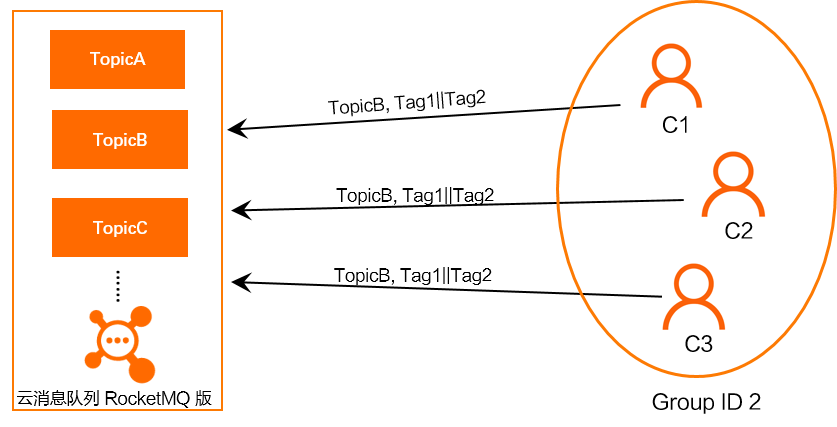 正确示例代码二
正确示例代码二
C1、C2、C3的订阅关系一致,即C1、C2、C3订阅消息的代码必须完全一致,代码示例如下:
Properties properties = new Properties();
properties.put(PropertyKeyConst.GROUP_ID, "GID_test_2");
Consumer consumer = ONSFactory.createConsumer(properties);
consumer.subscribe("TopicB", "Tag1||Tag2", new MessageListener() {
public Action consume(Message message, ConsumeContext context) {
System.out.println(message.getMsgID());
return Action.CommitMessage;
}
}); 正确订阅关系三:订阅多个Topic且订阅多个Tag
如下图所示,同一Group ID下的三个Consumer实例C1、C2和C3分别都订阅了TopicA和TopicB,且订阅的TopicA都未指定Tag,即订阅TopicA中的所有消息,订阅的TopicB的Tag都是Tag1和Tag2,表示订阅TopicB中所有Tag为Tag1或Tag2的消息,且顺序一致都是Tag1||Tag2,符合订阅关系一致原则。
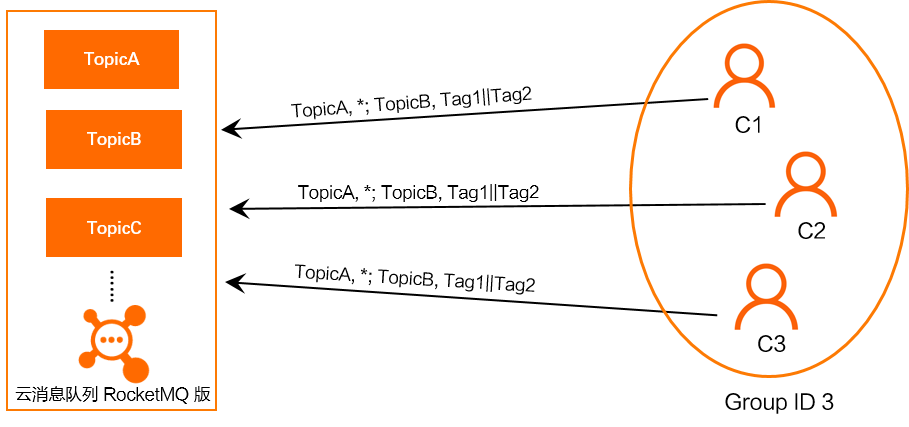 正确示例代码三
正确示例代码三
C1、C2、C3的订阅关系一致,即C1、C2、C3订阅消息的代码必须完全一致,代码示例如下:
Properties properties = new Properties();
properties.put(PropertyKeyConst.GROUP_ID, "GID_test_3");
Consumer consumer = ONSFactory.createConsumer(properties);
consumer.subscribe("TopicA", "*", new MessageListener() {
public Action consume(Message message, ConsumeContext context) {
System.out.println(message.getMsgID());
return Action.CommitMessage;
}
});
consumer.subscribe("TopicB", "Tag1||Tag2", new MessageListener() {
public Action consume(Message message, ConsumeContext context) {
System.out.println(message.getMsgID());
return Action.CommitMessage;
}
}); 常见订阅关系不一致场景
使用云消息队列 RocketMQ 版收发消息时,Consumer收到的消息不符合预期并且在云消息队列 RocketMQ 版控制台查看到订阅关系不一致,则Consumer实例可能存在以下问题:
错误示例一:同一Group ID下的Consumer实例订阅的Topic不同
如下图所示,同一Group ID下的三个Consumer实例C1、C2和C3分别订阅了TopicA、TopicB和TopicC,订阅的Topic不一致,不符合订阅关系一致性原则。
错误示例二:同一Group ID下的Consumer实例订阅的Topic相同,但订阅Topic的Tag不同
如下图所示,同一Group ID下的三个Consumer实例C1、C2和C3分别都订阅了TopicA,但是C1订阅TopicA的Tag为Tag1,C2和C3订阅的TopicA的Tag为Tag2,订阅同一Topic的Tag不一致,不符合订阅关系一致性原则。
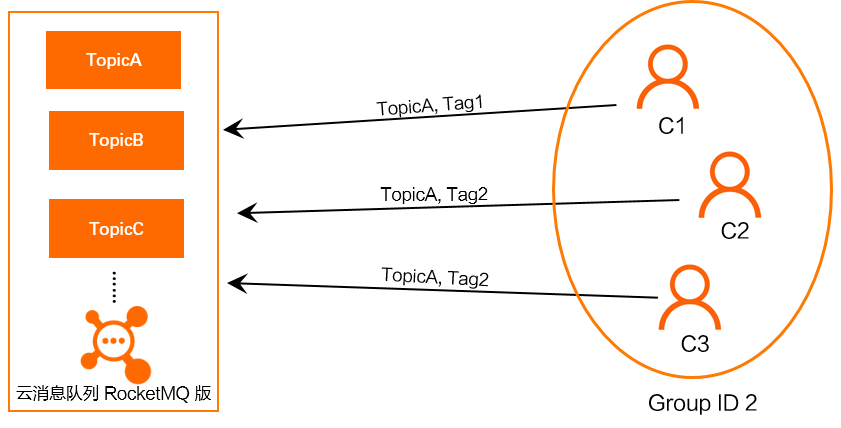
错误示例三:同一Group ID下的Consumer实例订阅的Topic及Topic的Tag都相同,但订阅的Tag顺序不同
如下图所示,同一Group ID下的三个Consumer实例C1、C2和C3分别都订阅了TopicA和TopicB,并且订阅的TopicA都没有指定Tag,订阅TopicB的Tag都是Tag1和Tag2,但是C1订阅TopicB的Tag为Tag1||Tag2,C2和C3订阅的Tag为Tag2||Tag1,顺序不一致,不符合订阅关系一致性原则。
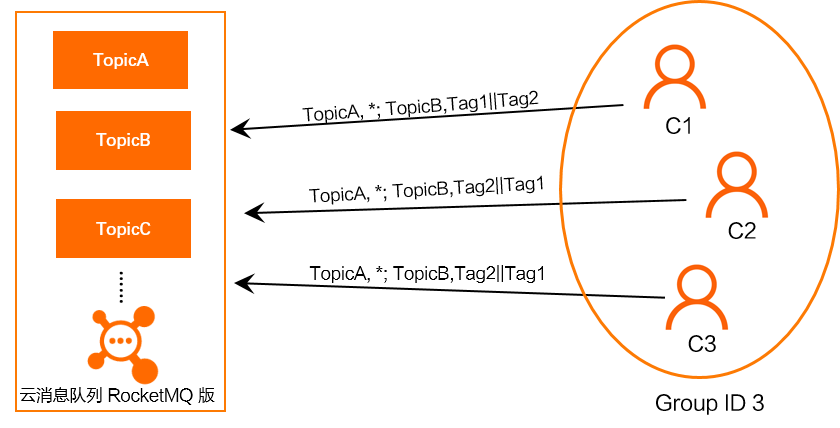
订阅关系常见问题
一个Group ID是否可以和多个Topic存在订阅关系?
支持,一个Group可以订阅多个Topic,该Group对于指定一个Topic的订阅算1个订阅关系,您需要确保每一个订阅关系中,Group下所有Consumer对于指定Topic的订阅都一致。
订阅关系是否支持手动删除?
订阅关系需要在消费者客户端代码中设置。

